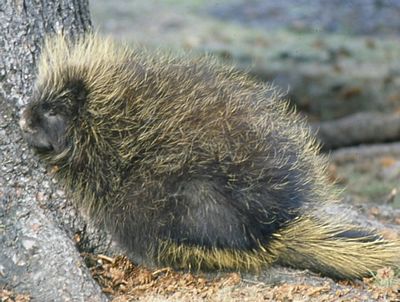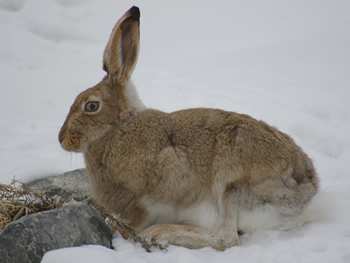|
|
|
There are some 4500 species of mammals in the world, including this Columbian Ground Squirrel. There are over 200 species in Canada and more than 400 in the United States.
All mammals have hair and females nurse their young with milk. |
|
After Africa's Cheetah, North America's Pronghorn is the second fastest land animal in the world attaining speeds of over
50 mph/80 k/h.
Such great speed evolved to escape now-extinct predators. |
| |
|
|
|
|
|
When necessary, the American Bison can run up to 40 mph/65 km/h. Their horns can grow up to 2 ft/61 cm long.
|
|
The Raccoon’s English name comes from the Algonquian word arukan which means “he who scratches with his hand.” |
| |
|
|
|
|
|
The Grizzly Bear has poor eye sight but excellent senses of smell and hearing. Long hairs on its head and shoulders are often white-tipped giving the bear a grizzled appearance, hence its common name. |
|
Some 30,000 quills cover the body of a Porcupine. The whole body is covered except for the bottom of the feet, stomach and nose. The quills are hollow, yellowish in colour with a black tip. The Porcupine is unable to shoot its quills, but they do act as a great defence. |
| |
__ |
|
|
|
|
The Beaver is the largest rodent in North America. It can reach over 3 ft/1 m in length. Its tail acts like a rudder helping it steer when swimming.
|
|
The largest member of the deer family is the Moose. The antlers of a mature male measure up to 150 cm. They are shed in November and grow again the following year.
|
| |
|
|
|
|
|
Earthworms are one the badger’s favourite things. They also feed on small rodents, birds, carrion, lizard, amphibians and even plant food. |
|
The squirrel’s bushy tail helps it when balancing and serves as a rudder when leaping and climbing. |
| |
|
|
|
|
|
Chipmunks are the smallest members of the squirrel family. They feed on nuts, berries, seeds and grains which they stuff into their cheek pouches and carry away to store. There are 25 species, 24 of which are found in North America. |
|
The Musk Ox is able to stand frigid Arctic temperatures due to its coat of dense wool which is covered with thick hair. During blizzards circles are formed around the calves protecting them from snow and wind.
|
| |
|
|
|
|
|
Jackrabbits are not rabbits but members of the hare family. They use their powerful hind legs to propel them on leaps of more than 10 ft/3 m. |
|
Black Bears vary in colour from black, brown, cinnamon, honey and grey to even white. When feeding for their winter sleep, they can put on 1.5 kg a day.
|
| |
|
|
|
|
|
Some whales and dolphins are dark on top and light underneath. This helps camouflage them against the dark of the deep water or light of the sky.
|
|
The River Otter has specially adapted clawed, webbed feet which are handy in water and on land. It is able to hold its breath underwater for up to 8 minutes. |
| |
|
|
|
|
|
The species name of the Bighorn Sheep is Ovis canadensis canadensis which means “sheep belonging to Canada.” Males have long spiral horns while females have shorter spike-like ones.
|
|
The White-tailed Deer is capable of making vertical leaps of over 2.5 m and horizontal leaps of nine metres. When sensing danger, raises its tail, a process called flagging. |
| |
|
|
|
|
|
Elk, also called Wapiti, are very large members of the deer family. A male’s antlers may tower 4 ft/1.2 m above its head. Antlers are shed each year. |
|
Mountain Goats are not true goats but are close relatives. They have cloven hooves with two toes which can spread wide to improve balance.
|
| |
|
|
|
|
|
The range of the Coyote is expanding in North America. In native folklore the Coyote is known as the trickster because of its cleverness. |
|
Despite the fact that there are over 2.4 million Caribou in Canada, most people have never seen one in the wild but it is featured on the Canadian 25 cent coin. |
| |
|
|
|
|
|
The elephant is the largest land mammal and the second tallest after the giraffe. It has knees on its back legs, but cannot jump.
|
|
The marmot is the largest member of the squirrel family of rodents called Sciuridae. Members of this family have 4 toes on the front feet and 5 on the back ones. This is the Yellow-bellied Marmot, Marmota flaviventris. |



.jpg)















